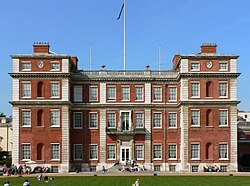Marlborough House
- Not to be confused with Marlborough House, Brighton
| Marlborough House | |
| Middlesex | |
|---|---|
 The south façade of Marlborough House | |
| Location | |
| Grid reference: | TQ29478010 |
| Location: | 51°30’18"N, 0°8’9"W |
| City: | Westminster |
| History | |
| Address: | St James's |
| Built 1711 | |
| By: | Christopher Wren |
| Town mansion | |
| Information | |
| Owned by: | The Crown |
'Marlborough House is a mansion in St James's, in the City of Westminster, which serves as the headquarters of the Commonwealth of Nations and the seat of the Commonwealth Secretariat.[1]
The house was built for Sarah Churchill, Duchess of Marlborough, the favourite and confidante of Queen Anne. For over a century it served as the London residence of the Dukes of Marlborough.
Marlborough House became a royal residence through the 19th century and first half of the 20th. It was leased by Queen Elizabeth II to the Commonwealth beginning in 1965.
The house is a Grade I listed building.[2]
Construction

The Duchess of Marlborough wanted her new town house to be "strong, plain and convenient and good". The architect Christopher Wren and his son of the same name designed a brick building with rusticated stone quoins (cornerstones) that was completed in 1711. Originally it had just two storeys.
The house was taken-up by the Crown in 1817.[3]
In the 1820s plans were drawn up to demolish Marlborough House and replace it with a terrace of similar dimensions to the two in neighbouring Carlton House Terrace, and this idea even featured on some contemporary maps, including Christopher and John Greenwood's large-scale London map of 1830, but the proposal was not implemented.[4]
Royal residence

Located north of The Mall and east of St James's Palace, Marlborough House was primarily used by members of the Royal Family, especially dowager queens and by Prince Albert Edward of Wales and his wife Alexandra. Queen Adelaide, widow of William IV, was given the use of Marlborough House from 1831 until her death in 1849.[5]
From 1853 to 1861 Prince Albert, the consort of Queen Victoria, arranged for the building to be used by the "National Art Training School", later the Royal College of Art.[6]
From 1861 to 1863, Sir James Pennethorne substantially enlarged the structure by adding a range of rooms on the north side and a deep porch for the Prince of Wales, later King Edward VII, and his wife the Princess of Wales, Alexandra of Denmark, who made their home the social centre of London.[7] Their second son, later King George V, was born at Marlborough House in 1865, and the family lived there until Victoria died in 1901, when Edward acceded the throne and they moved to nearby Buckingham Palace.

After Edward VII died in 1910, Alexandra again made Marlborough House her London home until her death in 1925. A late Art Nouveau-Gothic memorial fountain by Alfred Gilbert (1926–32) in the Marlborough Road wall of the house commemorates her.
In 1936, Marlborough House became the London residence of George V's widow, Queen Mary who survived George by 17 years. In the grounds of the house remains her pet cemetery. A thatch-roofed rotating summer house built for her is still in place.[1] A plaque to commemorate Queen Mary was unveiled by the Queen in 1967 in the exterior wall closest to the corner with the Mall.
Commonwealth Secretariat
After Queen Mary's death in 1953, Marlborough House continued to be used by various members of the royal family as a London residence before Queen Elizabeth II leased it to the Commonwealth Secretariat in 1965, an arrangement which continues today.
Features

The nearly cubical saloon retains wall-paintings by Louis Laguerre of the Battle of Blenheim (at which John Churchill, 1st Duke of Marlborough, was overall commander for Britain and her allies. A cupola inserted in the ceiling is surrounded by paintings by Orazio Gentileschi for the Queen's House, Greenwich, 1636. There are paired staircases flanking the saloon, with further battle pieces by Laguerre. Most of the interiors have been altered.[3]
Outside links
| ("Wikimedia Commons" has material about Marlborough House) |
References
- ↑ 1.0 1.1 Marlborough House: The Commonwealth Secretariat
- ↑ National Heritage List 1331701: Marlborough House
- ↑ 3.0 3.1 [https://books.google.com/books?id=LNwYAAAAYAAJ&dq=the+buildings+of+england%3A+westminster&focus=searchwithinvolume&q=marlborough+ Nikolaus Pevsner: Pevsner Architectural Guides
- ↑ Greenwood Map of London 1830
- ↑ Pall Mall, South Side, Past Buildings: Nos 66–68 (consec.) Pall Mall: The Junior Naval and Military Club (F. H. W. Sheppard, General Editor) Institute of Historical Research, 1960
- ↑ Frayling, Christopher (1987). The Royal College of Art, One Hundred and Fifty Years of Art and Design. London: Barrie & Jenkins. pp. 35-42. ISBN 978-0712617994.
- ↑ Jane Ridley, Marlborough House set (act. 1870s–1901) in Oxford Dictionary of National Biography (Oxford University Press)
- Stourton, James (2012). Great Houses of London. London: Frances Lincoln. ISBN 978-0-7112-3366-9. https://books.google.com/books?id=Jb7usgEACAAJ&dq=great+houses+of+london&hl=en&sa=X&ved=0ahUKEwi19-uouf3fAhVIs6wKHQbLDnsQ6AEIKDAA.
